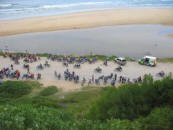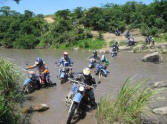|
Cara Mae attempts to combine two
incomplete Honda Rebel 250’s to make herself one reliable ride.
Absolutely no experience, just an itch to see if she can.
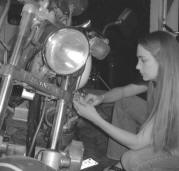
March 1, 2006
After a long winters hibernation,
my Rebel beckons me from the lonely garage. Yes I know, Diary, I have
neglected her. I make no excuses, can you ever forgive me? As I look
down upon the moto beast, I feel an inkling of anxiousness and I say
“Let’s Rock!” So I snatch up the carburetor placing it in the
confines of the engine. With a little wriggling and some lube on the
rubber tube, it does fit quite nicely. The carburetor is all attached
and tightened in snug. I work my way over to the air filter chamber
making sure the rubber tube is properly aligned, and insert air
filter element here as well, Bada Bing!
After the cover is put on
the air filter the sheet metal resides atop. Got to make it look
pretty, right? I proceed to the other side of my bike. Once I have
lubricated the throttle and choke cables, the ends are attached to
the carb. I had a heck of a time trying to get that smooth reflex
from the hand grip to the carb. I think I 3-in-1 oiled everything in
sight, until it finally dawned on me, take the stiff ol’ hand grip
off and lube the inside of it, Howdy Doo -it felt like butter! Today
is a good day.
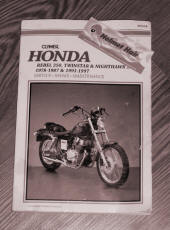
Important
note from Clymer: Proper air filter servicing can do more to ensure
long service from your engine than almost any other single item.
March 15, 2006
Today I must take a moment of pause for my:
Motorcycle Lament
Still so new to this sport and feeling that my time on the road has
been cut short. One motorcycle apart in the garage and the other
hopelessly sold for beginners sake. Now I must sit on the sidelines
and watch my friends whiz by, feeling the butterflies in my stomach
as their engines roar. Patience girl, your Honda is not so far off in
the distance. Until then I must bide my time with fleeting
moto-fantasies and the satisfaction of picking up the ol’ wrench. As
for right now, my Diary, I am officially a “Lady in Waiting”.
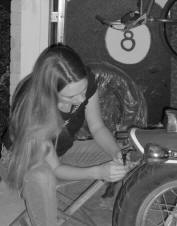
April 5, 2006
Okay, lets talk electrics/wiring. Now Diary, I am one lucky girl, I
tell ya! I managed to rewire and connect the blinkers and lighting
all in the first try. Oh yeah¼ after sorting out the tangled mess I
made. You should have been there in my dismay of routing the wires,
to and fro, under the fender, around the engine and along the frame.
I am not trying to toot my own horn, honestly I am truly amazed. Once
the battery was attached, I held my breath and hoped the ancient
biker mechanics would cut me a break. I’ll be darned, all the lights
worked: blinkers, headlight, brake and gear light. Not only that but
when I gave a little key turn to the ignition, low and behold, the
voice of my motorcycle was heard for the first time. I think mine
eyes were as big as saucers, and if you know me, that is rare! That’s
me- a proud mama.
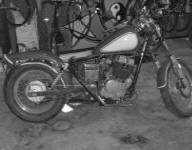
Yee-haw, just about done!!
Until next time , Diary…
Read Diary of a Virgin Motorcycle Mechanic from
the beginning |

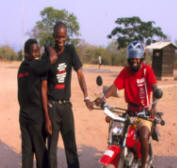
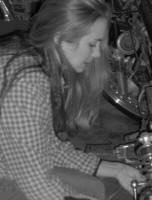




 Like
a lot of riders,
Like
a lot of riders,
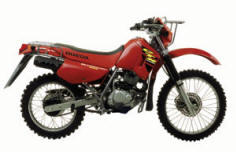 motorcycles. At the end of the 14 days,
Paula’s motorcycle will be donated to a
health worker in Africa that will virtually
have a live-saving effect on 20,000 people –
and that’s just her bike alone. Truly
amazing!
motorcycles. At the end of the 14 days,
Paula’s motorcycle will be donated to a
health worker in Africa that will virtually
have a live-saving effect on 20,000 people –
and that’s just her bike alone. Truly
amazing! Cornwall,
UK, I really appreciated the opportunities
that were opened to me because I had my own
cheap reliable transport, in the form of an
MZ125 when I was 17. When I read about
EnduroAfrica I knew it was something I
wanted to take part in. An adventure that
would challenge me and would help other
people in a way that most of us take for
granted.
Cornwall,
UK, I really appreciated the opportunities
that were opened to me because I had my own
cheap reliable transport, in the form of an
MZ125 when I was 17. When I read about
EnduroAfrica I knew it was something I
wanted to take part in. An adventure that
would challenge me and would help other
people in a way that most of us take for
granted.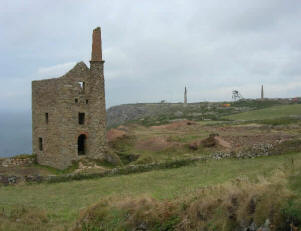 in the UK. Many jobs are seasonal
tourism positions and we have very little
manufacturing. Business sponsorship has been
hard to find as most choose to support
charities that are locally based. As I write
this I have so far raised £1123 on top of my
initial £500 contribution. This has been
donated mainly in amounts between £5 and £25
from individuals. To help with fundraising I
am running auctions of donated, secondhand
bike kit at rallies throughout the summer.
in the UK. Many jobs are seasonal
tourism positions and we have very little
manufacturing. Business sponsorship has been
hard to find as most choose to support
charities that are locally based. As I write
this I have so far raised £1123 on top of my
initial £500 contribution. This has been
donated mainly in amounts between £5 and £25
from individuals. To help with fundraising I
am running auctions of donated, secondhand
bike kit at rallies throughout the summer.
